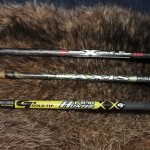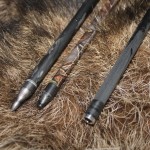For many hunters and target archers, the choice of arrows is most likely one based on brand loyalty and price. As technology has advanced in the arrow industry so has the price. Granted, the old adage, ‘you get what you pay for’ is true here, for many it’s difficult to justify spending $15-$20 per arrow. Even with their dependability and durability, it’s still a lot of money. That being said, once all others factors are considered, you should buy the best arrow you can afford. Fortunately, most major arrow manufacturers have styles and models in several price points.
Before we get to the price issue, we must first determine which arrow is best for your situation. The first step in selecting an arrow for your hunting adventures begins with selecting an arrow that is properly spined. (This is the term for measuring how stiff the arrow is along it’s horizontal axis) Far too many hunters choose arrows based on look or brand and what they shot in the past. However choosing an arrow too light will cause a lot of stress when it comes to tuning your bow to shoot accurately. As Mitch McKay of Gold Tip archery said “You cannot ever have too much spine on your arrow.” Choosing an arrow that is a bit heavier in spine is always better than choosing one too light. Fortunately, all major manufacturers have arrow selection charts on their websites that will help in determining the spine needed for your particular set up. If however, as in my case, my chart falls right on the line between two sizes, opt for the heavier arrow. In a hunting situation, penetration trumps speed every time.
Fortunately there are several options within the spine group for most to choose from varying in all price points and material. While carbon dominates the market in today’s world, there are still some good arguments for choosing aluminum in some cases. Even in the aluminum world, the arrows of today are far better than those of your father or even a few years ago.
We have chosen an arrow based on spine and one we can afford, now is the critical areas to get the most out of the arrows chosen. This begins with length, vanes and nocks.
If you are not sure of the length to cut your arrows, use your local bow shop for help here. Every fraction of an inch can improve performance. If you are a do it your self arrow maker, get a friend to help. Placing a full length arrow on the string, draw the bow back and have a friend mark the arros one inch beyond your arrow rest. This will give you ample clearance for your broadheads and provide great performance. For my set up, that equals 28 3/8” for a 29” draw length. The arrow is a short as I can make it and still provide the maximum performance.
For hunters setting up their broadheads, vane length can be critical to achieving optimum accuracy. Those who prefer fixed blade broadheads should consider the longer 3” or 4” vanes off set to get a great spin ratio, while those shooting mechanical broadheads can get away with the 2” variety of vanes. The choice of broadhead should dictate the vane selection, not looks. Tuning your broadheads (Next installment will cover this) depends on arrow performance and the vanes can have a huge impact on this.
Inserts for your arrows also affects your arrow performance. As you add components to your arrow, your weight distribution is changed. Fortunately, manufacturers such as Gold Tip have created a manner of improving the arrow balance with expandable weights in 5 grain increments that can adjust your arrows weight and balance. Experimenting with this can also help your arrows performance.
Lastly, when it comes to arrows in today’s market there is something to consider; that of full bodied shafts or the new micro-diameter shafts. Manufacturers have developed smaller diameter shafts with a very stiff spine. These may just be the best of both worlds. As the broadhead cuts a larger hole, there is virtually zero drag of the arrow through the animal causing greater penetration and more pass through shots. These micro-diameter arrows should be considered when deciding on an arrow for your set up.
The last thing to consider for your arrow is your nock. I prefer nocks that fit completely into the arrow shaft without the need of an insert. This reduces weight on the back of the arrow and allows for me to maneuver the nock for better alignment and rest clearance. I also prefer to use a nock that is easy to see in flight. While I personally have not tried the lighted nocks, I can see how these are great. But for my personal preference, neon green or white will help you in tracing your arrows flight.
The arrow is arguably the most important piece of equipment the archer can choose. Similar to rifle hunters who use a cheap scope and making poor shots, the archer can have great bow, but if the arrow never reaches the target at the precise spot, it’s all for naught. Choosing an arrow is not something to take lightly or because of the logo or color combinations, rather it’s about performance.






